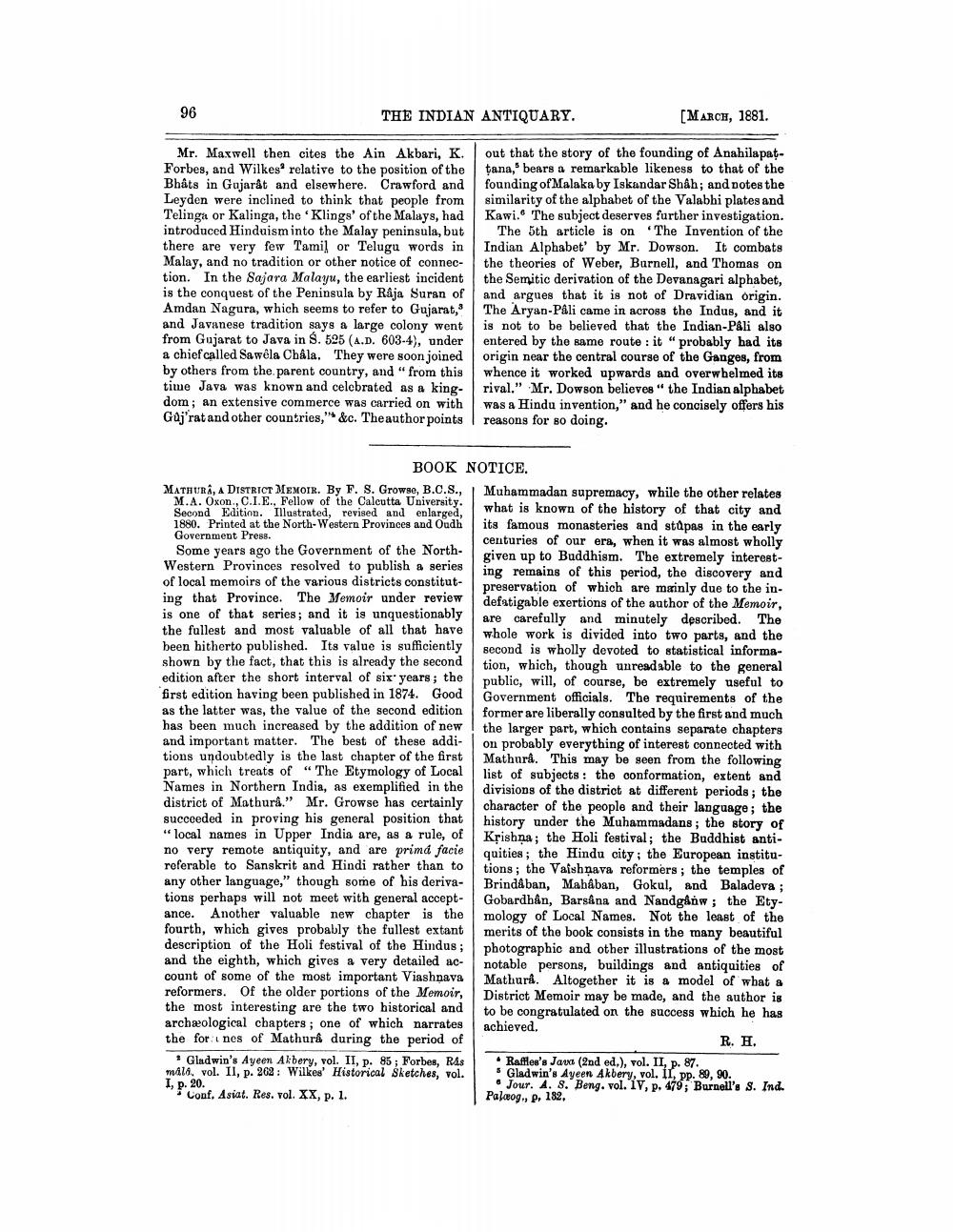________________
96
THE INDIAN ANTIQUARY.
[MARCH, 1881.
Mr. Maxwell then cites the Ain Akbari, K Forbes, and Wilkes relative to the position of the Bhâts in Gujarat and elsewhere. Crawford and Leyden were inclined to think that people from Telinga or Kalinga, the Klings' of the Malays, had introduced Hinduism into the Malay peninsula, but there are very few Tamil or Telugu words in Malay, and no tradition or other notice of connection. In the Sajara Malayu, the earliest incident is the conquest of the Peninsula by Raja Suran of Amdan Nagura, which seems to refer to Gujarat, and Javanese tradition says a large colony went from Gujarat to Java in $. 525 (A.D. 603-4), under a chief called Sawola Châla. They were soon joined by others from the parent country, and "from this time Java was known and celebrated as a king- dom; an extensive commerce was carried on with Gujrat and other countries,' &c. The author points
out that the story of the founding of Anahilapattana," bears a remarkable likeness to that of the founding of Malaka by Iskandar Shah; and potes the similarity of the alphabet of the Valabhi plates and Kawi. The subject deserves further investigation.
The 5th article is on 'The Invention of the Indian Alphabet' by Mr. Dowson. It combats the theories of Weber, Burnell, and Thomas on the Semitic derivation of the Devanagari alphabet, and argues that it is not of Dravidian origin. The Aryan-Páli came in across the Indus, and it is not to be believed that the Indian-Páli also entered by the same route : it "probably had its origin near the central course of the Ganges, from whence it worked upwards and overwhelmed its rival." Mr. Dowson believes " the Indian alphabet was a Hindu invention," and he concisely offers his reasons for so doing.
BOOK NOTICE. MATHURA, A DISTRICT MEMOIR. By F. S. Growse, B.C.S., Muhammadan supremacy, while the other relates
M.A. Oxon., C.I.E., Fellow of the Calcutta University. Second Edition. Illustrated, revised and enlarged,
what is known of the history of that city and 1880. Printed at the North-Western Provinces and Oudh its famous monasteries and stapas in the early Government Press.
centuries of our era, when it was almost wholly Some years ago the Government of the North
given up to Buddhism. The extremely interestWestern Provinces resolved to publish a series
ing remains of this period, the discovery and of local memoirs of the various districts constitut
preservation of which are mainly due to the ining that Province. The Memoir under review
defatigable exertions of the author of the Memoir, is one of that series; and it is unquestionably are carefully and minutely described. The the fullest and most valuable of all that have whole work is divided into two parts, and the been hitherto published. Its value is sufficiently
second is wholly devoted to statistical informashown by the fact, that this is already the second
tion, which, though unreadable to the general edition after the short interval of six years; the
public, will, of course, be extremely useful to first edition having been published in 1874. Good
Government officials. The requirements of the as the latter was, the value of the second edition
former are liberally consulted by the first and much has been much increased by the addition of new ! the larger part, which contains separate chapters and important matter. The best of these addi
on probably everything of interest connected with tions undoubtedly is the last chapter of the first Mathura. This may be seen from the following part, which treats of “The Etymology of Local list of subjects: the conformation, extent and Names in Northern India, as exemplified in the divisiong of the district at different periods; the district of Mathura." Mr. Growse has certainly
character of the people and their language; the succeeded in proving his general position that history under the Muhammadans; the story of "local names in Upper India are, as a rule, of Krishna; the Holi festival; the Buddhist antino very remote antiquity, and are prima facie quities; the Hindu city; the European institureferable to Sanskrit and Hindi rather than to tions; the Vaishnava reformers; the temples of any other language," though some of his deriva- Brind&ban, Mahâban, Gokul, and Baladeva; tions perhaps will not meet with general accept- Gobardhân, Barsâna and Nandgånw; the Etyance. Another valuable new chapter is the mology of Local Names. Not the least of the fourth, which gives probably the fullest extant merits of the book consists in the many beautiful description of the Holi festival of the Hindus;
photographic and other illustrations of the most and the eighth, which gives a very detailed ac
notable persons, buildings and antiquities of count of some of the most important Viashpava
Mathura. Altogether it is a model of what a reformers. Of the older portions of the Memoir,
District Memoir may be made, and the author is the most interesting are the two historical and to be congratulated on the success which he has archeological chapters; one of which narrates
achieved. the fornes of Mathurå during the period of
R. H. • Gladwin's Ayeen Akbery, vol. II, p. 85, Forbes, Res Raffles's Jaw (2nd ed.), vol. II, p. 87. mala, vol. II, p. 202: Wilkes' Historical Sketches, vol. 5 Gladwin's Ayeen Akbery, vol. II, pp. 80, 90.
Jour. A. 8. Beng. vol. IV, p. 479; Burnell's S. Ind. Conf. Asiat. Res. vol. XX, p. 1.
Palæog, p, 182
I, p. 20.




